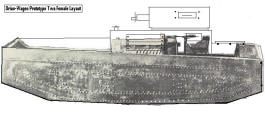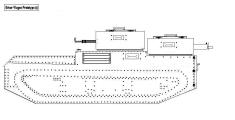
 |
|
#1
|
||||
|
||||
|
On May 14, 1917 the Germanís held a demonstration at Mainzer Sand for the OHL, following the Bremer-Wagen spectacle on May 5th, 1917. Von Hindenburg and Ludendorff were not present; they had lost faith in German tank concepts after the disappointing Bremer-Wagen demonstration. An OHL Supreme Army Command (Oberste Heeres Leitung) representative was present, Lieutenant Colonel Max Brauer, head of staff section O-H. L.C. M. Brauer had some influence with Ludendorff and was an influence on German arms production and Colonel Meyer, the Chefkraft. On this day, the A7V prototype wooden mock up was demonstrated and performed satisfactory. The Orion-Wagen, Treffas-Wagen and the Dur-Wagen were also demonstrated, but failed to win approval.
 The results of the Orion demonstration were published in the Mainzer Protokoll (Record of the Mainz Evaluation): "The Orion-Wagen's performance at the evaluation was not very admirable. The track system continually slipped and eventually broke. After repair and tightening of the track linkage, it performed ok. Crushing barbed wire and passing through the obstacles provided on the course with ease. It was not very successful in navigating over trenches, getting stuck frequently. The speed and pulling performance was hampered by it's relatively weak 45 Hp engine."  Talk had already began on the replacement of the engine prior to the evaluation. However, time did not permit. "How far the fifty ordered Orion-Wagen are suitable for armouring remains to be seen. The chassis are expected in late summer. The peculiarities of the Orion drive with its feet make it doubtful whether it can actually cross wire entanglements.". Although the Motor Transport experts very early stated that the Orion track system would not work sufficiently under field conditions. The project had some High ranking friends in the OHL, which saw that the project was not cancelled. An order for 50 vehicles was placed, but only 29 completed and 16 were accepted for Army service. After the Mainz evaluation, the Orion-Wagen tank project was withdrawn, but it was continued and developed as a tracked transporter. Orion-Wagen I Prototype One  The original Orion-Wagen tank design was thought to be based on a Orion Plough or Landwirtschaftlicher Traktor Orion, this in incorrect. It was based on a standard Orion produced 4 ton Lkw (lorry), to which a set of the very odd footed Orion type tracks were added. The Orion type track feet were extremely complicated. Each foot had a large spring in between the top and bottom track pad; which would compress when the Orion tracks rolled around, and helped with the forward drive propulsion. These feet were attached to a steel band running around the track causers. The Orion-Wagen Prototype One was also aided in steering by a large steel wheel attached to the front, reminiscent to the Holt style steering wheel. The Orion-Wagen produced for the trials at Mainz was armoured in sheet metal, no armament was present on the prototype, but provisions were allocated for 4 Maxim machine guns. One machine gun per side of the driverís position, one in the rear in the center of the entrance door, and one was envisioned to be fitted into the nose, over the front steering wheel. The Orion-Wagen was never fitted with its armor or armament. The Orion-Wagen's performance at the evaluation was not very adequate. Orion-Wagen II Prototype Two     A second prototype was developed in late 1917; in this version the front steering wheel was removed. A completely new approach was taken on this design. Armament was also to be 4 Maxim machine guns, as well as a Male version was planned to include a 2cm Tankabwehrkanone Becker M.11, a gun original designated to be placed in the A7V. These versions were projected to have a fully rotatable turret, they were offered as an alternative arrangement to the first prototype. But, by then, the OHL was set on the A7V, and no interest could be found. A single prototype was produced, and sheet metal was used to cover the track system, no other armor was placed. Orion-Wagen III  This version was designed for use in the Plan for 1919. Even though it never reached the prototype stage, it did make it to the design and drawing stage. It was envisioned to carry two turrets, the main turret was to hold a 2cm Tankabwehrkanone Becker M.11., and the secondary turret behind the main turret would house a Maxim machine gun. The Orion-Wagens structure would be rearranged slightly in the rear to house the secondary turret. These versions resembled the LK (Leichte Kampfwagen) Light fighting vehicle series, LKI and LKII. Orion-Wagen (Zugmaschinen) One Armee-Kraftwagen-Kolonne (Raupe)-A.K.K.R. 1116 was equipped with the Orion-Wagen in 1918. But results in the field soon proved the motor transport experts right, the vehicle was unusable, The Orion-Wagens were altered, by removing the large track system, replacing the front wheel to a standard Lkw type tire, and redesigning the Orion track system, to the same specifications as the Benz-Brauer Half- Track design, except it retained its peculiar track feet. Also the engines which started out as 45 hp were replaced with 100 hp Daimler engines, the same ones used in the A7V. Speed would have been around 8 Km/H and it would have weighed 7 metric tons. After they were decommissioned, the engines were removed, and used as spares for the A7V Marienwagens. |
| Sponsored Links |


|